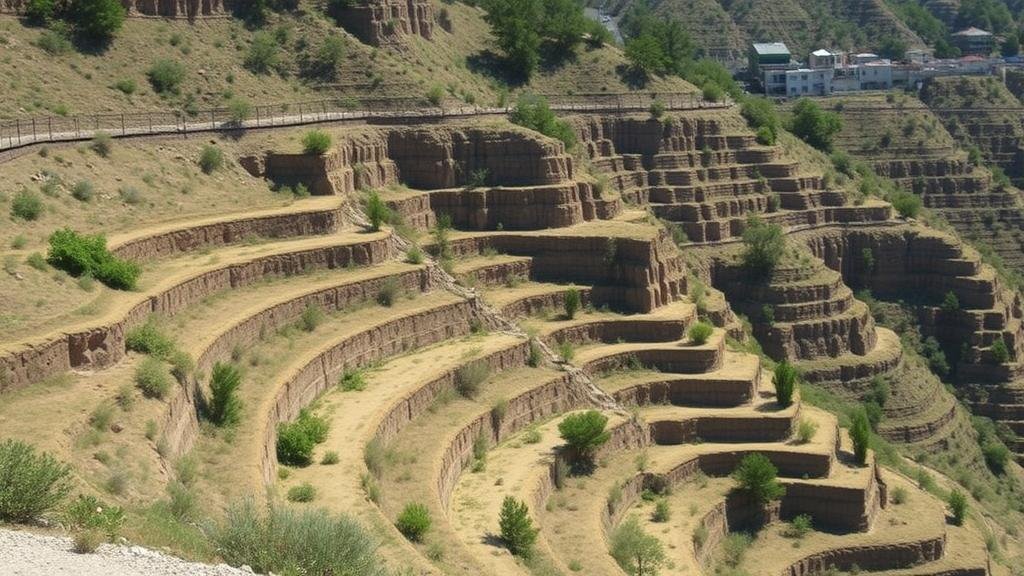Using Natural Erosion to Locate Artifacts in Steep Hillside Terraces
Using Natural Erosion to Locate Artifacts in Steep Hillside Terraces
Understanding how natural erosion can assist archaeologists in uncovering artifacts hidden within steep hillside terraces is pivotal in the field of archaeology. Steep terraces, often formed through geomorphological processes, can challenge traditional excavation methods. This article delves into the environmental and geological dynamics that favor artifact dispersion, along with methodologies used for locating these artifacts in eroded hillside contexts.
The Basics of Erosion and Its Impact on Archaeology
Erosion refers to the process by which soil and rock are removed from the Earths surface by wind, water, or ice, and transported to other locations. In archaeological contexts, natural erosion can reveal artifacts that would otherwise remain concealed beneath layers of sediment. This phenomenon occurs more frequently in steep hillside terrains where gravitational forces, precipitation, and vegetation interplay significantly.
Research indicates that approximately 30% of archaeological sites are subject to some form of erosion, underscoring the relevance of erosion as both a challenge and a tool for archaeologists (Smith et al., 2020). In steep terrains, the prevailing slope gradient plays a critical role in influencing how quickly erosion occurs and the types of artifacts likely to be uncovered.
Understanding Steep Hillside Terraces
Steep hillside terraces are commonly formed through a combination of natural geological processes, human activity, and climatic factors. typically consist of flat or gently sloping land positioned on vertical or nearly vertical hillsides. Their formation may be the result of historical agricultural practices or the natural upslope movement of soil and debris.
These terraces can serve as rich archaeological sites due to their potential to preserve cultural materials, including tools, pottery, and structural remains. For example, the terraces of the Inca civilization in Peru, exemplify how elevated landscapes can bear significant archaeological artifacts reflective of past human behavior (Hastorf, 2016).
The Mechanism of Artifact Exposure
Erosion exposes artifacts by stripping away layers of soil that have buried them over time. Different types of erosion can facilitate this exposure in various ways:
- Surface Erosion: This type of erosion involves the removal of topsoil by rainwater runoff. It can lead to the exposure of artifacts situated just beneath the surface.
- Mass Wasting: On steep slopes, gravitational pull can cause soil and rock to move downhill. This process can dislodge artifacts and carry them downslope, scattering them over larger areas.
- Fluvial Erosion: Water flowing down a hillside can carve channels, removing large quantities of material and exposing artifacts along riverbanks or in sediment deposits downstream.
These mechanisms highlight the duality of erosion–as a force that can both displace artifacts and offer archaeologists the chance to discover them in situ.
Field Methods for Locating Artifacts
Archaeological fieldwork in steep hillside terraces requires tailored methodologies to effectively locate and recover artifacts exposed through natural erosion. A combination of techniques is often employed:
- Visual Survey: Archaeologists often begin with a visual survey, where they systematically walk the area, identifying any visible artifacts that may have been exposed by erosion.
- Geophysical Surveying: Techniques such as ground-penetrating radar (GPR) can help archaeologists identify buried structures or artifacts that are not immediately visible.
- Soil Sampling: Collecting soil samples at various depths can help archaeologists determine the extent and type of artifacts present beneath the surface.
Case studies, such as the site of the easterly terraces at Machu Picchu, demonstrate successful methodologies where artifacts were located after heavy rains caused flash flooding that eroded the hillside (Culley et al., 2021).
Real-World Applications and Ethical Considerations
The findings from such archaeological pursuits pay dividends not only in enhancing our understanding of historical human activity but also in preserving cultural heritage. But, these investigations necessitate ethical considerations, particularly around how artifacts are handled and preserved once uncovered.
Plus, the impact of climate change, which exacerbates erosion conditions, calls for an urgent need to adapt archaeological practices. For example, the National Park Service in the United States has initiated programs that explore how ongoing erosion might threaten significant archaeological sites due to increased weather events associated with climate change.
Conclusion: Actionable Takeaways
Utilizing natural erosion to locate artifacts in steep hillside terraces elucidates the interplay between environmental dynamics and archaeological practices. Effective methodologies can lead to significant discoveries that enrich our understanding of ancient civilizations. As archaeologists embrace these challenges, it is crucial to develop sustainable practices that prioritize the preservation of both artifacts and their contexts. By balancing discovery with ethical stewardship, future generations can continue to glean insights from the past.



